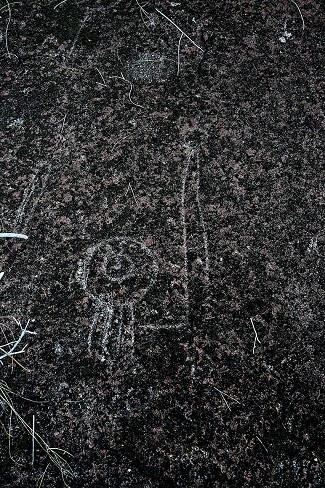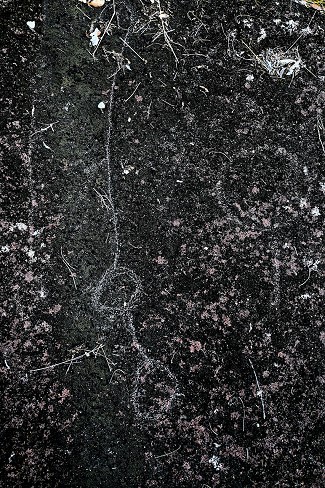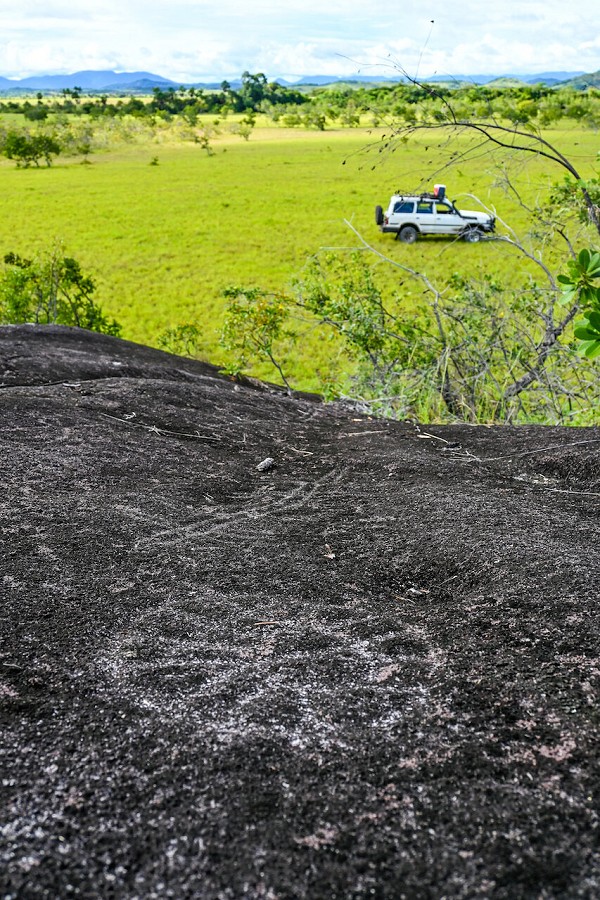
Alex Outhwaite visits a little-known petroglyph site on Barawatau Mountain, Guyana.
"We always leave something at places like this for the spirits," Leroy says, lighting up a cigarette. "So I'll leave them a bit of tobacco."
We're stood at the top of Barawatau Mountain in the Savannah of Guyana - The Southern Rupununi - only around 40km from the border with Brazil. It's a very remote region, characterised by large black rocky outcrops, the cooled remnants of ancient magma chambers, dotted around the landscape overlooking vast savannah. Some are easily hikeable, while others require more climbing skills.
It's impossible to travel here by public transport, so my friends and I hired the services of Leroy Ignacio for the duration of the trip. An expert guide, conservationist and experienced driver, Leroy was born in the Rupununi and is part of the 5% of the population of Guyana who don't live on the coast.
With a population of less than 800,000 and only 3,000 tourists a year, Guyana offers a truly rugged and adventurous travel experience for the more intrepid traveller, where it's possible to travel for days without coming across more than a handful of people. As a tourist, the selfish yet obvious plus side to this is having the 'attractions' totally to yourself.
At Termite City in the Central Rupununi, thousands of termite mounds over 10 foot tall loom in the distance. It's a genuinely jaw-dropping sight and from afar looks like something dreamed up on a Spielberg set, yet apart from my friends and me, there couldn't have been anyone else within miles. In comparison to neighbouring Brazil, where almost every natural attraction has thousands of visitors a day, and often long queues to take photos, Guyana still gives you the feeling that you're one of a small number of people who have had the fortune of visiting these spots.
One such site, and an important historical find that shows the region has been inhabited for thousands of years, can be found on Barawatau. Dated back to over 6000 years ago, a number of petroglyphs - hand drawn rock carvings - have been discovered creeping up the side of the 'mountain'. The carvings are undeciphered and with the tribe they are believed to have come from no longer being in existence, it's unlikely a definitive answer can ever be given.
"Everyone can make their own conclusions about them," Leroy says. "Although there's one to me that looks like a map of where to go fishing." He points to a petroglyph about a metre in length and consisting of a slightly curved line with a number of white circles at points along it. Of course, if you're living off the land, then keeping 'notes' of sorts to remind yourself of successful hunting or fishing spots does make sense.
This kind of assessment could only be made by someone who knows the region so well, a trait found in many of the people we met in the South with their knowledge of the land and its workings. A seemingly inconspicuous row of trees to someone from the Rupununi means an obvious water source, while higher levels of rainfall means you're less likely to spot the giant river otters on the Rupununi River.
Local knowledge and culture forms much of the basis of tourism in the Rupununi. Our accommodation hosts at Wichabai Ranch, Justin and Erin, have four cabins available for tourists to come and stay, a low number presumably to ensure that over-tourism doesn't become a problem in the region. As well as being a base for visiting the Petroglyph sites, Wichabai also offers the chance to learn about the way of life of the vaqueros as they sort cattle and prepare for rodeo, and to visit local families to learn about cassava collection and preparation. A conscious effort has been made to ensure that tourism not only protects the cultures and customs of the Rupununi, but actively celebrates it.
Three petroglyph sites have now been discovered in the Savannahs of Guyana in the shadows of the Kanuku Mountains. With so many of the formations being more challenging to climb, combined with overgrowth, I asked Leroy if he thought there could be more on some of the higher rocks and mountains or hills in the region.
"Yes, it's a possibility, although some might be hard to see if there has been rockfall," he says.
Leroy explains: 'The petroglyphs are in Wapisiana territory, but as there is only an oral history of this period, nobody can explain who did it. The tribes will have known back in the day of course, but it wasn't recorded.'
In Guyana, Amerindians make up nearly 10% of the population, but there are frequent challenges to the communities from a number of forces including climate change and the impact of the mining industry, which makes the importance of these historical sites all the more acute.
Guyana isn't the only place to have had recent historical carving discoveries in difficult-to-reach spots. AlUla, the former capital of the Dedanite / Lihyanite kingdoms was a thriving city 2500 years ago, yet until 2019 when Saudi Arabia opened for tourism, the remains of tombs and towering rocks have been somewhat overlooked and most definitely under-climbed.
On his recent trip to AlUla, adventurer Steve Backshall was given special permission to climb one of three giant adjoining rock pinnacles for his show 'Expedition'. While archaeologists had previously explored some of the rock faces, there were a number of routes to the top that hadn't been climbed in centuries. Taking on the steep Western side route, Steve enlisted the help of British climber Leo Houlding and Aldo Kane acting as a rope rigger to help them reach the top. An initial recce with a drone shows a series of coiled walls a few hundred feet up.
"From a military perspective, that's 100% a sort of look out," Aldo suggests, and his observation makes sense, with the location giving a clear vantage point over the flat sands below. Reaching the top of the final pinnacle via this route eventually proved too challenging even for Steve, so it's left to Leo to attempt the final summit first. He jugs up two ropes beforeclimbing the sheer sandstone wall using the 'ancient chip marks from chisels' for hand holds. With ropes then in place, the team are able to join Leo for the final ascent, which includes an ancient 'staircase' carved into the rock some few hundred feet up.
At the top they discovered hundreds of inscriptions in the rocks from over 2000 years ago - so surprising to local archaeologists that the team weren't even allowed to show the carvings on camera. When deciphered, the discovery could significantly change our understanding of the history of the region.
Of course, with even Leo Houlding finding the aforementioned climb a challenge, your average person wouldn't be able to replicate his experience. In Guyana, the locations of the petroglyphs are as yet not recorded public knowledge, so without a local guide would be almost impossible to find.
However, according to the Getty Conservation Institute, despite these recent petroglyph discoveries frequently being found in high or equally hard-to-reach places, many are still at risk due to developmental pressures, climate impacts and poor tourist management. With many of these sites representing records of 'complex knowledge and spiritual beliefs' as well as for many the only remaining record of their ancestors, the importance of these discoveries and their protection cannot be overlooked.
- ARTICLE: The Last Ice Man of Chimborazo 7 Apr, 2021





















Comments